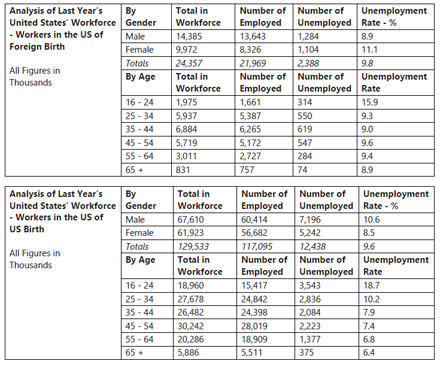This is a model response to a Writing Task 1 topic from High Scorer’s Choice IELTS Practice Tests book series (reprinted with permission). This answer is close to IELTS Band 9.
Set 1 Academic book, Practice Test 3
Writing Task 1
You should spend about 20 minutes on this task.
The two tables below show statistics of workers of foreign and US birth in the United States last year.
Summarise the information by selecting and reporting the main features, and make comparisons where relevant.
You should write at least 150 words.

Sample Band 9 Report
The two tables compare from last year the number of workers in the US that were of US birth to the number of workers who were of foreign birth. The tables include divisions of the workforce by gender and by age, summarising the total number of workers in the workforce, the number of employed and unemployed workers and finally the unemployment rate. All figures are in thousands.
When looking at the breakdown of the figures by gender, the male foreign birth workforce suffered a lower unemployment rate (8.9%) than the male US birth workforce (10.6%), whereas the female foreign birth workforce suffered a higher unemployment rate (11.1%) than the female US birth workforce (8.5%). Overall, the male foreign birth workforce suffered a marginally higher rate of unemployment (9.8%) than the US birth workforce (9.6%). The total US birth workforce in size was significantly larger (129,533 people) than the total foreign birth workforce (24,357 people).
When looking at the breakdown of the figures by age, the younger of the foreign birth workforce (16 – 24 and 25 – 34) suffered from lower unemployment rates than the workforce of native birth, however, the foreign workforce older than these bands suffered higher unemployment rates.
In conclusion, in spite of the much larger numbers involved with the US birth workforce, the percentage differences in terms of unemployment were never very different with the largest difference being 2.8% higher rate for the US birth workforce found in workers between the ages of 16 – 24.
Go here for more IELTS Band 9 Reports
https://ift.tt/3uQA4co
from IELTS-Blog https://ift.tt/2TEUcl8
via IFTTT
No comments:
Post a Comment